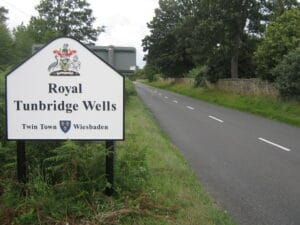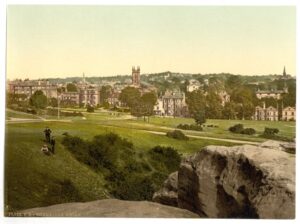Tunbridge Wells is a small town in Kent, England. Tunbridge Wells has been inhabited since Paleolithic times. In the United Kingdom Census 2001
A long time ago, over 400 years ago, a natural well came up from the ground, named “The Tunbridge Wells.” Queen Anne visited, but when Queen Victoria made the town part of her regular holiday trips, the town became a place that is called “Royal Tunbridge Wells.”
Visitors have been coming to Tunbridge Wells since they discovered the Chalybeate Spring back in 1606. Over the years, the town grew in popularity and gained its track record to see and be seen.
In 1684, widow of Viscount Purbeck, Margaret, whose love of fashion and dancing had gotten her the nickname which was “The Princess of Babylon”, provided they arrive on Mount Sion which was the earliest lodging houses also the ground at the northern end of the Pantiles, also where the Church of King Charles was built.
Visitors who had pertained to “take the waters” needed a location for praise and kindly contributed a huge amount of money to construct a church.
Sir Christopher Wren sent his main chief plasterer Henry Toogood to produce its magnificent ceiling. It was here that Princess Victoria participated in church services with her mother, the Duchess of Kent.
The Wells ended up being a preferred location for a fashionable society that required lodging and wanted a place to entertainment such as coffee houses, gaming rooms and an assembly room for dances and balls. And so the town started to spread out.
The Grove is the earliest park in Tunbridge Wells. In 1703, it was given to the townspeople to provide “a shady place or walk” and privacy from the stress of the town.
A deed of the endowment was drawn up to make sure that the trees in the Grove were secured. The Grove continues to provide a sanctuary of tranquillity for residents and visitors.

The town ended up being increasingly popular with people looking for the pleasure of retirement and began to bring in an influx of permanent residents.
Fabulous 19th-century architecture, Calverley Park Crescent – picture by Chris ParkerThe cost of living was more affordable than in London; however, it was possible to get to London as stagecoaches ran a trusted service from Tunbridge Wells to London with the journey just taking five hours!
The environment was a fantastic asset to the town “romantic, rural, rugged with a wide variety of different views …”.
The surrounding beautiful countryside was perfect for walks and rides, and early guide books of the town explained the country houses that could be checked out in the location. High Rocks was a favourite tourist attraction and a famous expedition.
Entertainment for homeowners and visitors occurred on the Common, including firework displays, cricket matches, archery and horse racing.
In 1750 Girl Coke wrote to her friend Mrs Eyre describing a typical day in Tunbridge Wells: “The outside amusements are cricketing, horse races and other diversions, such as strolling, riding and airing in carriages.”.
The residents petitioned for the destruction of the races in 1845 on the grounds “that they were a cause of drunkenness and riotous behaviour.” However, once the racecourse was stopped, the racecourse was saved as a walkway and bridle-way, which can still be followed today.

Royal Tunbridge Wells coat of arms – image by Chris ShoebridgeToday, Royal Tunbridge Wells, or Tunbridge Wells is more typically called, remains a popular place to live and to visit as it maintains much of its initial charm and beauty.
Surrounded by gorgeous countryside and just a short distance from London, it is an ideal location for a short break.
Wish to find out more about the colourful history of Royal Tunbridge Wells? Then why not use up the alternative of booking a Guided Walking Tour for a group.
Additionally, you can listen to the tales of Tunbridge Wells on the audio app, which is free.
With so much to discover, why not remain for a few days? But, first, examine our accommodation pages to find the best location to stay.
Tunbridge Wells is a town in England, located on the border of Kent and East Sussex. Since Roman times, the area has been inhabited, and it was an important place for people to retire to because of its countryside scenery. It also offers visitors attractions such as Royal Tunbridge Wells Park with its magnificent fountains and high rocks, which provide some great views over the surrounding countryside. There are some excellent walks through the area, and you can even walk to the nearby town of Royal Tunbridge Wells, which allows you to see some more attractive architecture.
This is also an excellent place for people who are interested in history. The Old Town Hall has historical records from the Roman period that can be viewed by visitors and other artefacts that show what life was like here in earlier years. There are many things to do in Royal Tunbridge Wells because it offers a range of activities for every kind of visitor. If you love the outdoors, there are opportunities for walking and cycling through the countryside scenery, which will take you past beautiful towns and villages along the way.
If art is your thing, galleries are showing modern works of art, and Tunbridge Wells also offers some great shopping opportunities with a range of independent shops and shops offering all manner of high street fashions.
Royal Tunbridge Wells Park is a great place to take the family for an afternoon out because there are plenty of play areas for children, including funfairs and a boating lake which kids will love. It’s easy to see how Royal Tunbridge Wells became a royal settlement with its beautiful surroundings, abundant greenery and friendly community spirit that has remained over the centuries. The town is worth exploring if you want to discover Britain’s rich past while enjoying some truly spectacular views.
Tunbridge Wells is a town in England, located on the border of Kent and East Sussex. Since Roman times, the area has been inhabited, and it was an important place for people to retire to because of its countryside scenery. It also offers visitors attractions such as Royal Tunbridge Wells Park with its magnificent fountains and high rocks, which provide some great views over the surrounding countryside. There are some great walks through the area, and you can even walk to the nearby town of Royal Tunbridge Wells, which allows you to see some more attractive architecture. This is also an excellent place for people who are interested in history. The Old Town Hall has historical records from the Roman period that visitors and other art can view. So why not visit today
Admin@allseasonsleisurehire.co.uk
Kents #1 trusted leisure hire
company.
Phone Number +447753211035
Address: 1 Yew Tree Cl, Chatham ME5 8XN, United Kingdom
Open Mon – Sun
9am – 7pm
Plus Code: 8HJ2+8X Chatham, United Kingdom
| Cookie | Duration | Description |
|---|---|---|
| cookielawinfo-checkbox-analytics | 11 months | This cookie is set by GDPR Cookie Consent plugin. The cookie is used to store the user consent for the cookies in the category "Analytics". |
| cookielawinfo-checkbox-functional | 11 months | The cookie is set by GDPR cookie consent to record the user consent for the cookies in the category "Functional". |
| cookielawinfo-checkbox-necessary | 11 months | This cookie is set by GDPR Cookie Consent plugin. The cookies is used to store the user consent for the cookies in the category "Necessary". |
| cookielawinfo-checkbox-others | 11 months | This cookie is set by GDPR Cookie Consent plugin. The cookie is used to store the user consent for the cookies in the category "Other. |
| cookielawinfo-checkbox-performance | 11 months | This cookie is set by GDPR Cookie Consent plugin. The cookie is used to store the user consent for the cookies in the category "Performance". |
| viewed_cookie_policy | 11 months | The cookie is set by the GDPR Cookie Consent plugin and is used to store whether or not user has consented to the use of cookies. It does not store any personal data. |